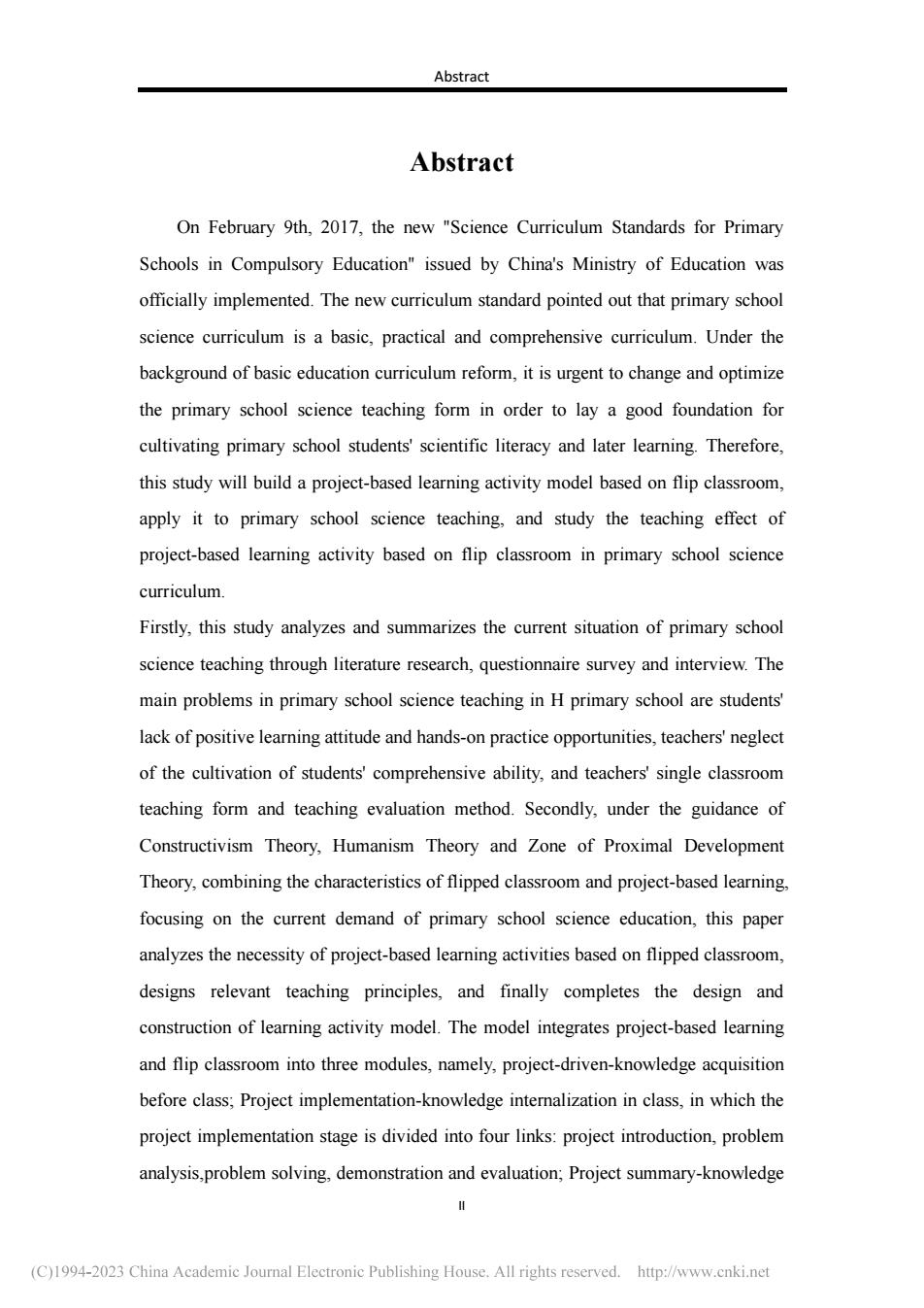
Abstract Abstract On February 9th,2017,the new "Science Curriculum Standards for Primary Schools in Compulsory Education"issued by China's Ministry of Education was officially implemented.The new curriculum standard pointed out that primary school science curriculum is a basic,practical and comprehensive curriculum.Under the background of basic education curriculum reform,it is urgent to change and optimize the primary school science teaching form in order to lay a good foundation for cultivating primary school students'scientific literacy and later learning.Therefore, this study will build a project-based learning activity model based on flip classroom. apply it to primary school science teaching,and study the teaching effect of project-based learning activity based on flip classroom in primary school science curriculum. Firstly,this study analyzes and summarizes the current situation of primary school science teaching through literature research,questionnaire survey and interview.The main problems in primary school science teaching in H primary school are students' lack of positive learning attitude and hands-on practice opportunities,teachersneglect of the cultivation of students'comprehensive ability,and teachers'single classroom teaching form and teaching evaluation method.Secondly,under the guidance of Constructivism Theory,Humanism Theory and Zone of Proximal Development Theory,combining the characteristics of flipped classroom and project-based learning. focusing on the current demand of primary school science education.this paper analyzes the necessity of project-based learning activities based on flipped classroom. designs relevant teaching principles,and finally completes the design and construction of learing activity model.The model integrates project-based learning and flip classroom into three modules,namely,project-driven-knowledge acquisition before class;Project implementation-knowledge internalization in class,in which the project implementation stage is divided into four links:project introduction,problem analysis.problem solving.demonstration and evaluation;Project summary-knowledge (C)1994-023 China Academie Joural Electronic Publishing House.All rights reserved.http://www.enki.net
Abstract II Abstract On February 9th, 2017, the new "Science Curriculum Standards for Primary Schools in Compulsory Education" issued by China's Ministry of Education was officially implemented. The new curriculum standard pointed out that primary school science curriculum is a basic, practical and comprehensive curriculum. Under the background of basic education curriculum reform, it is urgent to change and optimize the primary school science teaching form in order to lay a good foundation for cultivating primary school students' scientific literacy and later learning. Therefore, this study will build a project-based learning activity model based on flip classroom, apply it to primary school science teaching, and study the teaching effect of project-based learning activity based on flip classroom in primary school science curriculum. Firstly, this study analyzes and summarizes the current situation of primary school science teaching through literature research, questionnaire survey and interview. The main problems in primary school science teaching in H primary school are students' lack of positive learning attitude and hands-on practice opportunities, teachers' neglect of the cultivation of students' comprehensive ability, and teachers' single classroom teaching form and teaching evaluation method. Secondly, under the guidance of Constructivism Theory, Humanism Theory and Zone of Proximal Development Theory, combining the characteristics of flipped classroom and project-based learning, focusing on the current demand of primary school science education, this paper analyzes the necessity of project-based learning activities based on flipped classroom, designs relevant teaching principles, and finally completes the design and construction of learning activity model. The model integrates project-based learning and flip classroom into three modules, namely, project-driven-knowledge acquisition before class; Project implementation-knowledge internalization in class, in which the project implementation stage is divided into four links: project introduction, problem analysis,problem solving, demonstration and evaluation; Project summary-knowledge
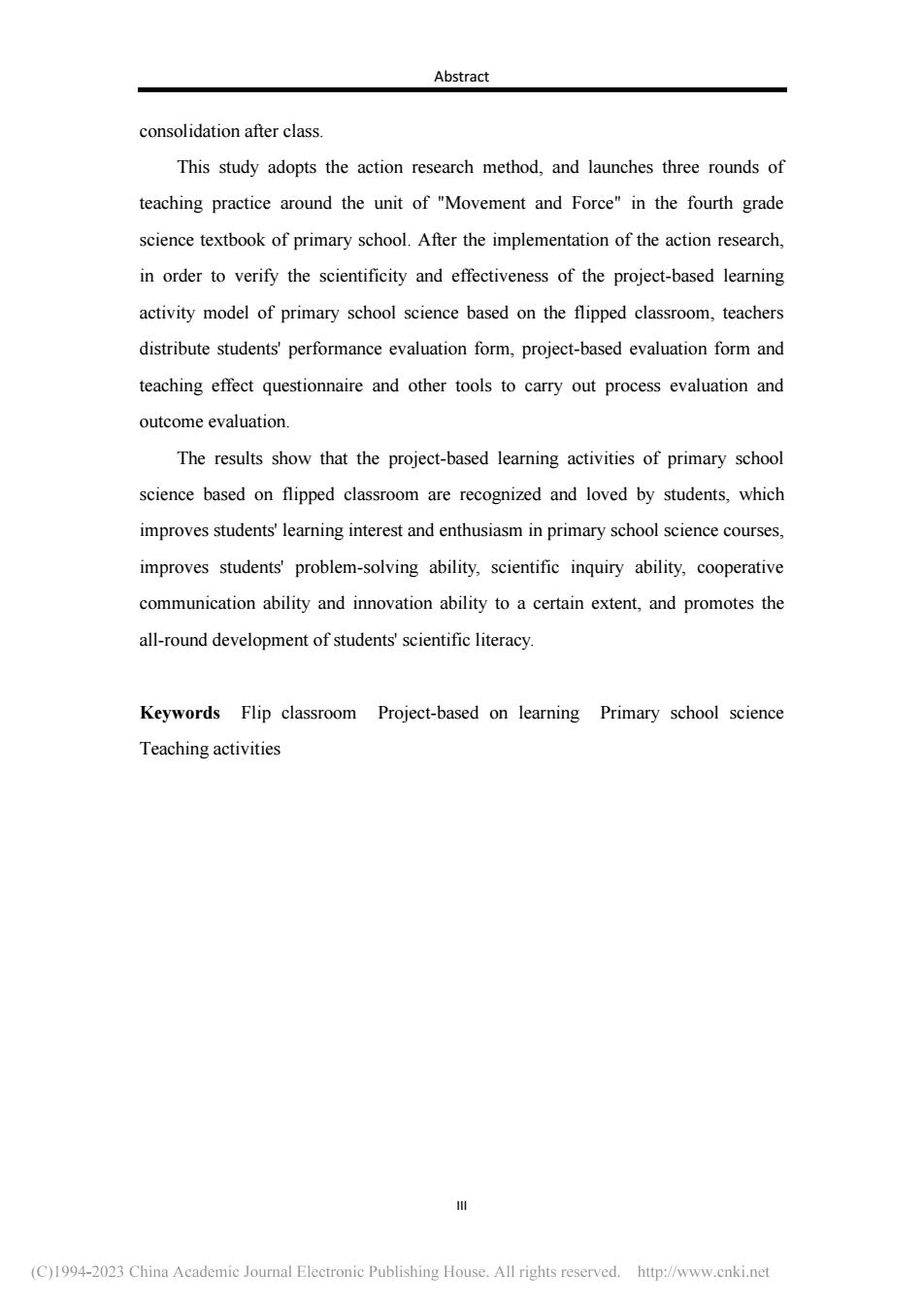
Abstract consolidation after class. This study adopts the action research method,and launches three rounds of teaching practice around the unit of"Movement and Force"in the fourth grade science textbook of primary school.After the implementation of the action research. in order to verify the scientificity and effectiveness of the project-based learning activity model of primary school science based on the flipped classroom.teachers distribute students performance evaluation form,project-based evaluation form and teaching effect questionnaire and other tools to carry out process evaluation and outcome evaluation. The results show that the project-based learning activities of primary school science based on flipped classroom are recognized and loved by students,which improves students'learning interest and enthusiasm in primary school science courses, improves students problem-solving ability,scientific inquiry ability,cooperative communication ability and innovation ability to a certain extent,and promotes the all-round development of studentsscientific literacy. Keywords Flip classroom Project-based on learning Primary school science Teaching activities (C)1994-023 China Academie Joural Electronic Publishing House.All rights reserved.http://www.enki.net
Abstract III consolidation after class. This study adopts the action research method, and launches three rounds of teaching practice around the unit of "Movement and Force" in the fourth grade science textbook of primary school. After the implementation of the action research, in order to verify the scientificity and effectiveness of the project-based learning activity model of primary school science based on the flipped classroom, teachers distribute students' performance evaluation form, project-based evaluation form and teaching effect questionnaire and other tools to carry out process evaluation and outcome evaluation. The results show that the project-based learning activities of primary school science based on flipped classroom are recognized and loved by students, which improves students' learning interest and enthusiasm in primary school science courses, improves students' problem-solving ability, scientific inquiry ability, cooperative communication ability and innovation ability to a certain extent, and promotes the all-round development of students' scientific literacy. Keywords Flip classroom Project-based on learning Primary school science Teaching activities
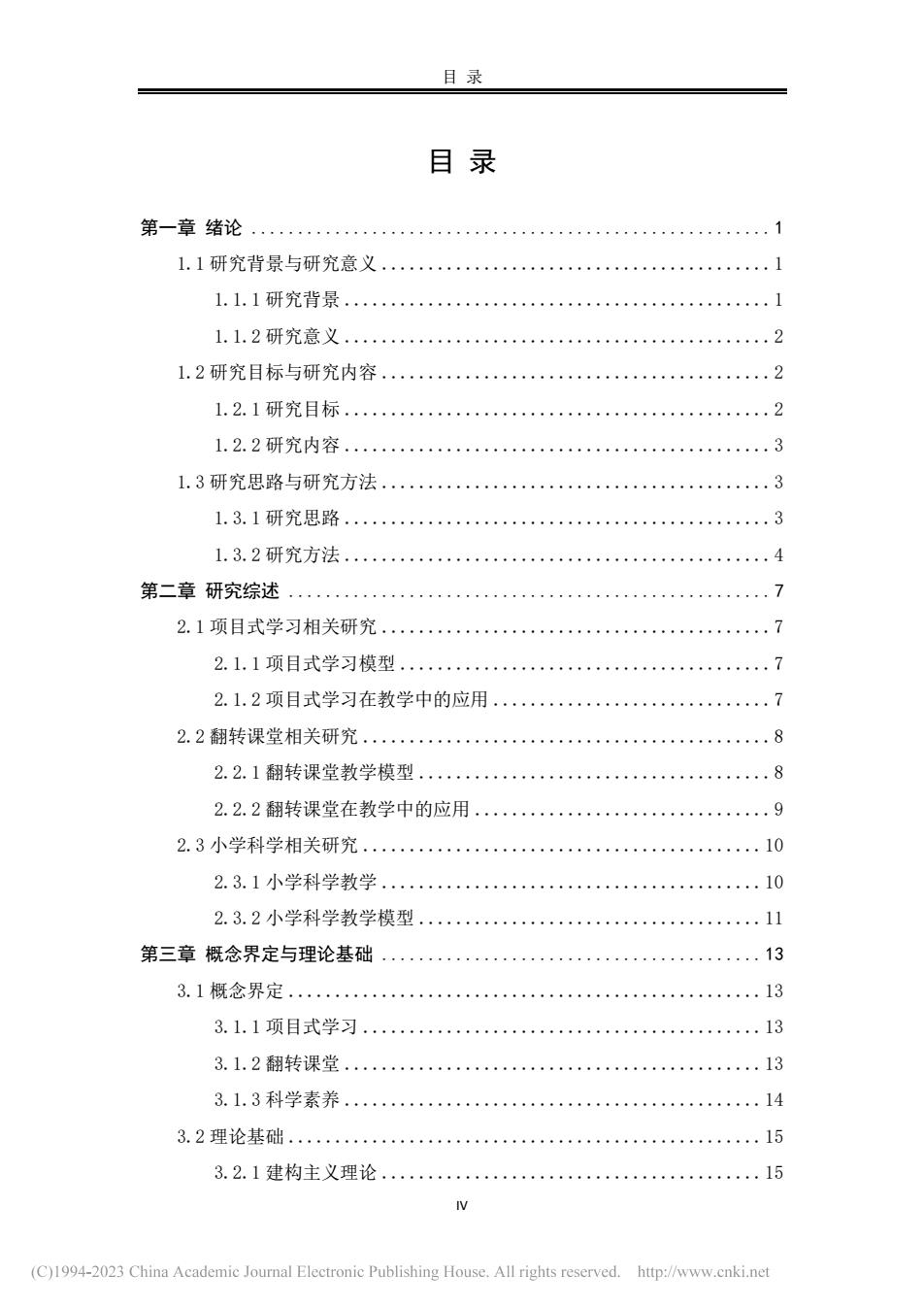
目录 目录 第一章绪论 .1 1.1研究背景与研究意义.1 1.1.1研究背景.1 1.1.2研究意义.2 1.2研究目标与研究内容.2 1.2.1研究目标.2 1.22研究内容.3 1.3研究思路与研究方法.3 1.3.1研究思路3 1.32研究方法.4 第二章研究综述 .7 21项目式学习相关研究.7 2.1.1项目式学习模型.7 2.1.2项目式学习在教学中的应用.7 22翻转课堂相关研究.8 2.2.1翻转课堂教学模型.8 2.2.2翻转课堂在教学中的应用.9 2.3小学科学相关研究. .10 2.3.1小学科学教学.10 2.3.2小学科学教学模型.11 第三章概念界定与理论基础.13 3.1概念界定13 3.1.1项目式学习.13 3.1.2翻转课堂.13 3.1.3科学素养.14 32理论基础.15 3.2.1建构主义理论.15 (C)1994-2023 China Academie Joumal Electronic Publishing House.All rights reserved.http://www.enki.net
目 录 IV 目 录 第一章 绪论 .1 1.1 研究背景与研究意义 .1 1.1.1 研究背景 .1 1.1.2 研究意义 .2 1.2 研究目标与研究内容 .2 1.2.1 研究目标 .2 1.2.2 研究内容 .3 1.3 研究思路与研究方法 .3 1.3.1 研究思路 .3 1.3.2 研究方法 .4 第二章 研究综述 .7 2.1 项目式学习相关研究 .7 2.1.1 项目式学习模型 .7 2.1.2 项目式学习在教学中的应用 .7 2.2 翻转课堂相关研究 .8 2.2.1 翻转课堂教学模型 .8 2.2.2 翻转课堂在教学中的应用 .9 2.3 小学科学相关研究 .10 2.3.1 小学科学教学 .10 2.3.2 小学科学教学模型 .11 第三章 概念界定与理论基础 .13 3.1 概念界定 .13 3.1.1 项目式学习 .13 3.1.2 翻转课堂 .13 3.1.3 科学素养 .14 3.2 理论基础 .15 3.2.1 建构主义理论 .15
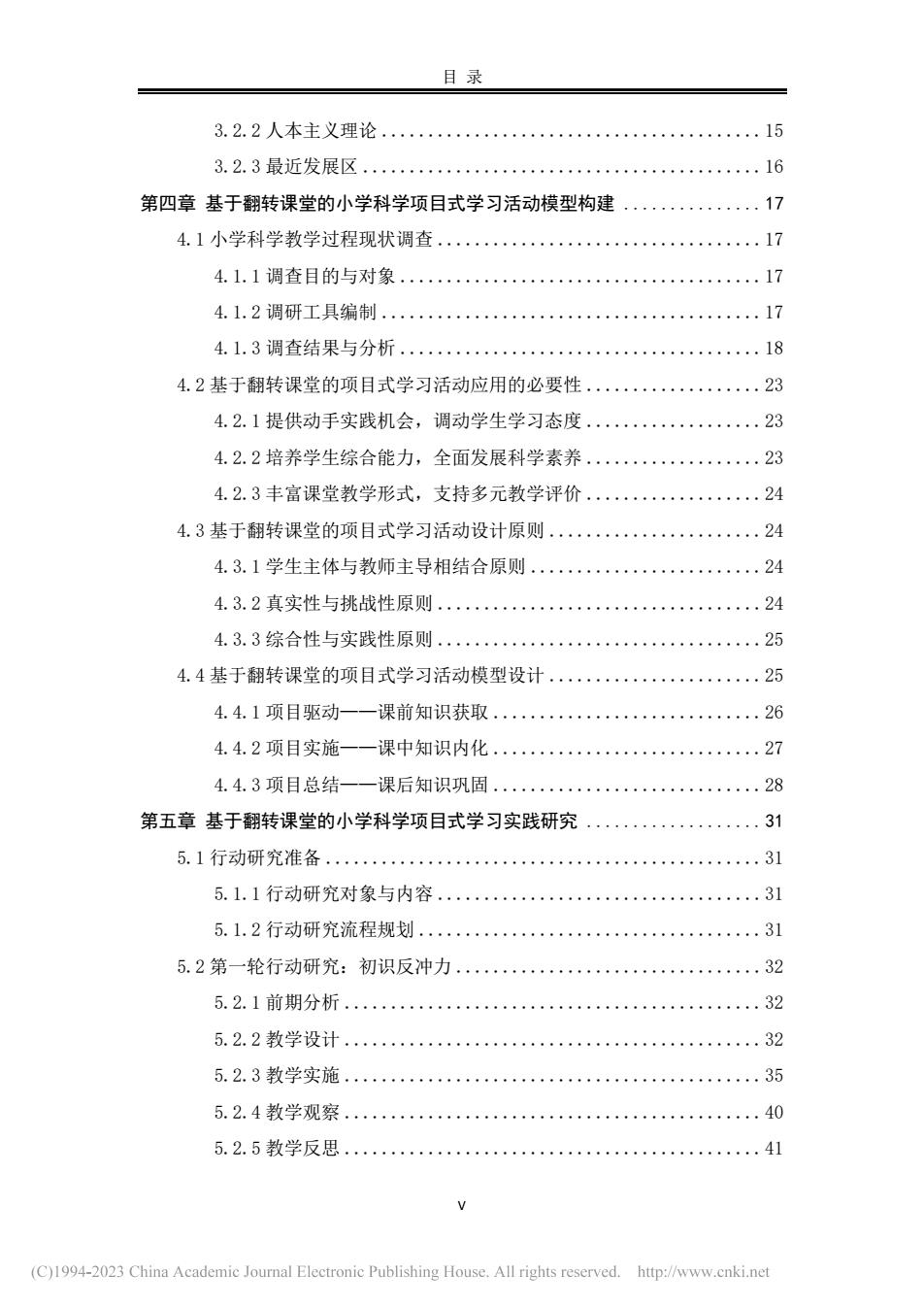
目录 3.2.2人本主义理论.15 3.2.3最近发展区16 第四章基于翻转课堂的小学科学项目式学习活动模型构建.17 4.1小学科学教学过程现状调查.17 4.1.1调查目的与对象.17 4.1.2调研工具编制. .17 4.1.3调查结果与分析.18 4.2基于翻转课堂的项目式学习活动应用的必要性.23 4.2.1提供动手实践机会,调动学生学习态度.23 4.22培养学生综合能力,全面发展科学索养.23 4.2.3丰富课堂教学形式,支持多元教学评价.24 4.3基于翻转课堂的项目式学习活动设计原则.24 4.3.1学生主体与教师主导相结合原则. .24 4.3.2真实性与挑战性原则. 24 4.3.3综合性与实践性原则.25 4.4基于翻转课堂的项目式学习活动模型设计.25 4.4.1项目驱动-一课前知识获取.26 4.4.2项目实施一一课中知识内化.27 4.4.3项目总结一一课后知识巩固.28 第五章基于翻转课堂的小学科学项目式学习实践研究.31 5.1行动研究准备.31 5.1.1行动研究对象与内容.31 5.1.2行动研究流程规划.31 5.2第一轮行动研究:初识反冲力. .32 5.2.1前期分析.32 5.2.2教学设计.32 5.2.3教学实施.35 5.2.4教学观察.40 52.5教学反思.41 (C)1994-023 China Academie Joumal Electronic Publishing House.All rights reserved.http://www.enki.net
目 录 V 3.2.2 人本主义理论 .15 3.2.3 最近发展区 .16 第四章 基于翻转课堂的小学科学项目式学习活动模型构建 .17 4.1 小学科学教学过程现状调查 .17 4.1.1 调查目的与对象 .17 4.1.2 调研工具编制 .17 4.1.3 调查结果与分析 .18 4.2 基于翻转课堂的项目式学习活动应用的必要性 .23 4.2.1 提供动手实践机会,调动学生学习态度 .23 4.2.2 培养学生综合能力,全面发展科学素养 .23 4.2.3 丰富课堂教学形式,支持多元教学评价 .24 4.3 基于翻转课堂的项目式学习活动设计原则 .24 4.3.1 学生主体与教师主导相结合原则 .24 4.3.2 真实性与挑战性原则 .24 4.3.3 综合性与实践性原则 .25 4.4 基于翻转课堂的项目式学习活动模型设计 .25 4.4.1 项目驱动——课前知识获取 .26 4.4.2 项目实施——课中知识内化 .27 4.4.3 项目总结——课后知识巩固 .28 第五章 基于翻转课堂的小学科学项目式学习实践研究 .31 5.1 行动研究准备 .31 5.1.1 行动研究对象与内容 .31 5.1.2 行动研究流程规划 .31 5.2 第一轮行动研究:初识反冲力 .32 5.2.1 前期分析 .32 5.2.2 教学设计 .32 5.2.3 教学实施 .35 5.2.4 教学观察 .40 5.2.5 教学反思 .41
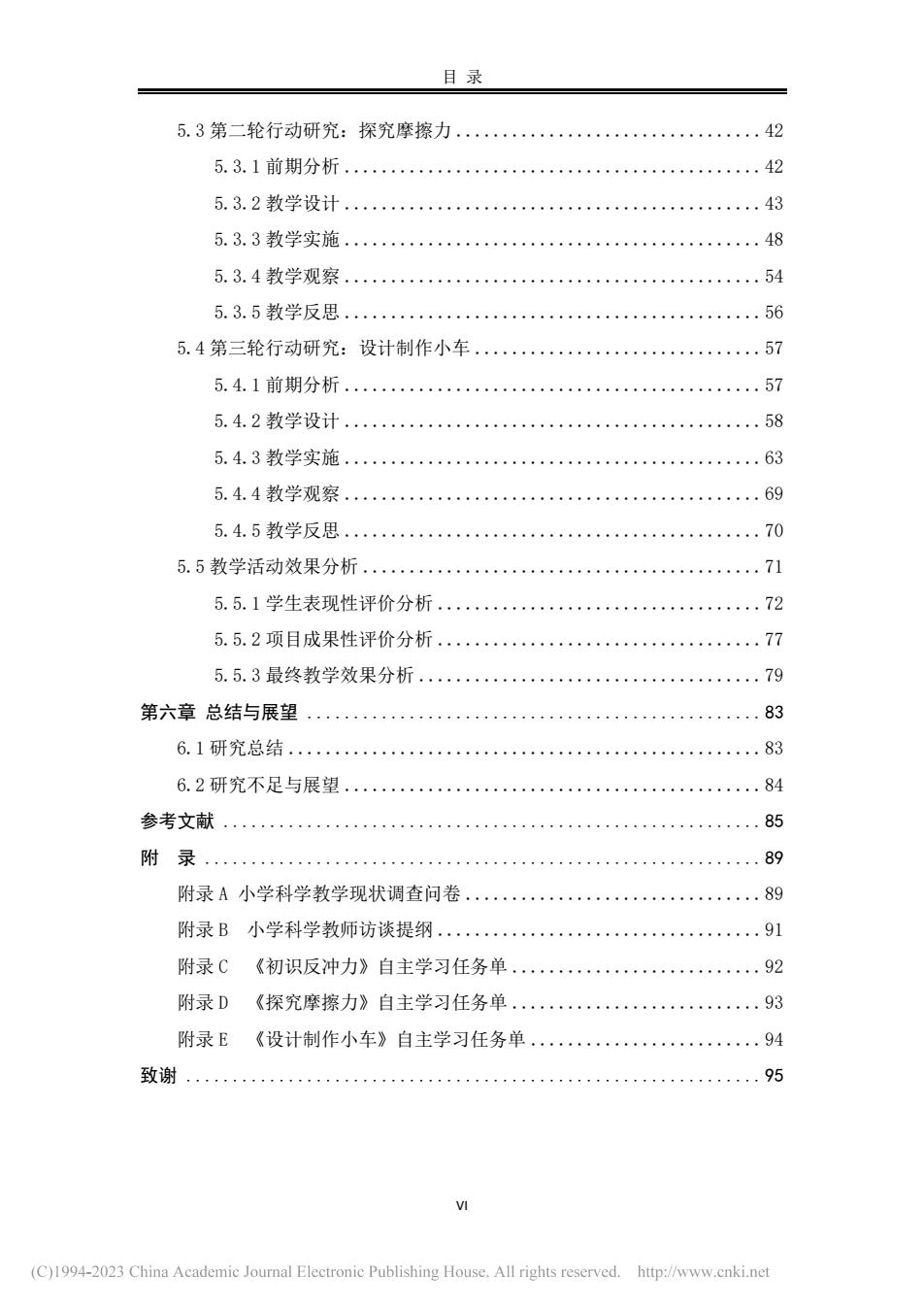
目录 5.3第二轮行动研究:探究摩擦力.42 5.3.1前期分析.42 5.3.2教学设计.43 5.3.3教学实施.48 5.3.4教学观察.54 5.3.5教学反思. .56 5.4第三轮行动研究:设计制作小车.57 5.4.1前期分析.57 5.4.2教学设计.58 5.4.3教学实施.63 5.4.4教学观察.69 5.45教学反思.70 5.5教学活动效果分析.71 5.5.1学生表现性评价分析.72 5.5.2项目成果性评价分析.77 5.5.3最终教学效果分析.79 第六章总结与展望. .83 6.1研究总结.83 62研究不足与展望.84 参考文献85 附录89 附录A小学科学教学现状调查问卷.89 附录B小学科学教师访谈提纲.91 附录C《初识反冲力》自主学习任务单.92 附录D《探究摩擦力》自主学习任务单.93 附录E《设计制作小车》自主学习任务单.94 致谢95 (C)1994-2023 China Academie Joumal Electronic Publishing House.All rights reserved.http://www.enki.net
目 录 VI 5.3 第二轮行动研究:探究摩擦力 .42 5.3.1 前期分析 .42 5.3.2 教学设计 .43 5.3.3 教学实施 .48 5.3.4 教学观察 .54 5.3.5 教学反思 .56 5.4 第三轮行动研究:设计制作小车 .57 5.4.1 前期分析 .57 5.4.2 教学设计 .58 5.4.3 教学实施 .63 5.4.4 教学观察 .69 5.4.5 教学反思 .70 5.5 教学活动效果分析 .71 5.5.1 学生表现性评价分析 .72 5.5.2 项目成果性评价分析 .77 5.5.3 最终教学效果分析 .79 第六章 总结与展望 .83 6.1 研究总结 .83 6.2 研究不足与展望 .84 参考文献 .85 附 录 .89 附录 A 小学科学教学现状调查问卷 .89 附录 B 小学科学教师访谈提纲 .91 附录 C 《初识反冲力》自主学习任务单 .92 附录 D 《探究摩擦力》自主学习任务单 .93 附录 E 《设计制作小车》自主学习任务单 .94 致谢 .95